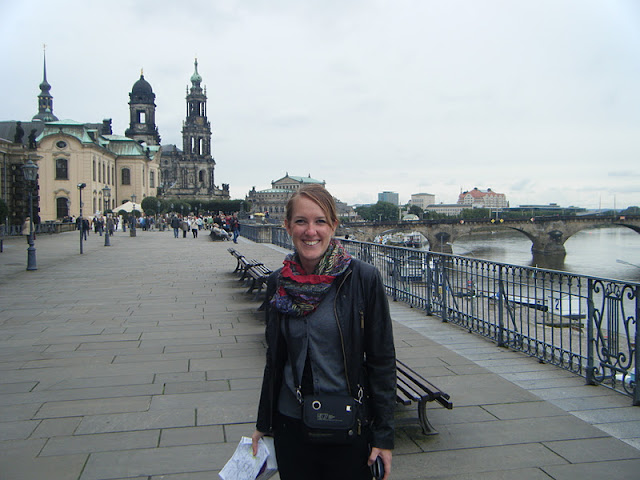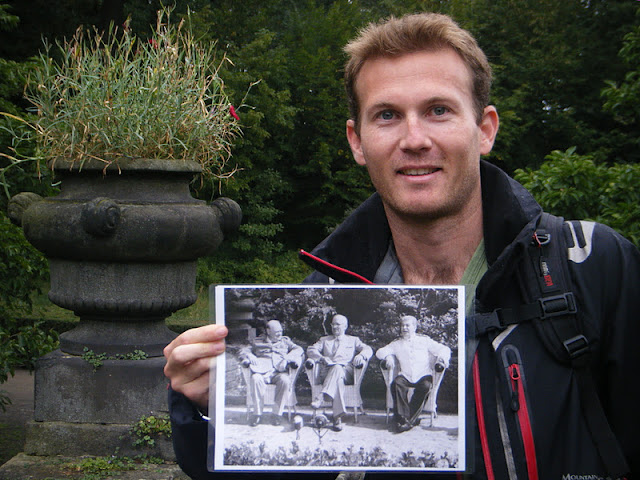More history in store of us today with another Insider Tour to the Nazi concentration camp of Sachenhausen (pronounced Saxenhousen).
We arrived via DeuscheBahn (regional railway) the same company and lines that transported Nazi prisoners all over Germnay, to the town of Oranienburg known as the town of the SS as this is where many SS soldier and their families.
 |
| Oranienburg train station - end of the line |
From here we were marched through the town along the same route inmates took towards he gates of Sachenhausen – the first purpose built concentration camp and the one used for a model for all other concentration camps as well as training SS soldiers for the holocaust and guided tours for foreign dignitaries from Fascist countries.
Dachau near
Munich was actually the very first camp but this was built in the triangular shape to become famous for subjugating inmates to the “Absolute Power” of the SS.
 |
| The entry to Sachenhausen |
Our guide Jakub took us through a detailed explanation of the camp structure, on a model as many buildings were destroyed, explaining how the design of the camp was just as essential to the oppression of the people as was starvation executions and exterminations. We were surprised at the scale of the camp covering 4000 football fields! It encompassed the barrack areas as well as a major brickworks factory owned by the SS and used to send particularly undesirable inmates there – the life expectancy was 3months if you were assigned to this wok group.
 |
| Plan of the original camp |
Next we visited “the green monster” as it was named by the inmates. Actually not as sinister as it sounds, this was the common room building used by the SS to drink and play cards after a hard days work.

Here Jakub put a human face on the SS soldiers painting them not as psychopathic blonde haired blue eyed men from a Hollywood movie but as 20-21year olds (the average ages was 20.7years) accepted as the cream of the cream of the Aryan crop. To get into the SS you had to be at least 180cm tall and be able to prove your Aryan descent from at least 1775. Then you were given a snappy Hugo Boss designed uniform and cool weapons and almost worshipped as the perfect example of a perfect race. The only division of the SS involved with the running of the concentration camp was known as the Death’s Head – identified by the skull on their hats. Basically to get in was a great honour and you entered with all the great friends you had made in the Hitler Youth and you get to dominate the lowest of the low and save society from their evil influences. Even biology taught in schools proved how if you had a relationship with Jewish, Sinti or Roma person you were statistically likely to produce offspring 50% of whom were likely to have physical and mental defects – they were heavily indoctrinated in Nazi beliefs.
 |
| The idelic tree lined boulevards along the original wall of the camp |
From here we actually entered the gate of the camp with its ironic German quote “work will set you free.”
 |
| Work will set you "free" (if you consider freedom as going up in smoke through a chimney. |
This was located under Tower A – the main watch tower of the camp which was designed so that no matter where in the camp you were you could see the tower (and of course it could see you!) The irony comes into it when new inmates passed through the dates receiving a welcome speech from the camp commander who told them directly that the only way they would ever leave Sachenhausen was through the chimneys of block Z, this obviously being the block holding the extermination chambers and crematorium. Poetically the Nazi’s named the buildings according to the lifecycle of an inmate – in at tower A, out at block Z.
 |
| Tower A |
However not everything went to plan (as would be expected of Germans) in the early days of the camp before they had a crematorium on site they transported bodies via truck into
Berlin to use the facilities there. This quickly ended when a truck dropped its cargo right in the middle of
Berlin – not a good look for the Nazis. However the camps continued on unhindered, even with the locals of Oranienburg living right next to its walls.
 |
| The assembly area |
We followed the footsteps of the inmates into the central assembly are used morning and night for role call – basically where they counted the prisoners rain hail or shine. The process usually taking place for 30mins but could take as long as the soldiers felt like.
Surrounding this area was a gravel path called the “shoe testing area.” A local company making boots for Nazi soldiers wanted to test the endurance of the various boots. Happily the SS volunteered inmates as slave labourers to run up and down the paths for an entire work shift (14hours) with no break day after day. When they had their results they realized they were flawed as the inmates were not carrying loads like soldiers would, so they repeated the task having inmates also carry 20kg sandbags on their backs. Obviously prisoners given this work detail had a very short life expectancy. Added to this they were also the ones usually volunteered to test pharmaceuticals being designed to keep soldiers on the front awake – AKA speed, so they often did not sleep for days on end and quickly died of exhaustion.
 |
| The shoe testing path |
In addition to tower A, the only remaining original buildings of the camp are the kitchen and laundry.
The kitchen now converted into a museum displaying various artifacts such as prisoners uniforms, the camp gallows and the punishment rack where 25 beatings of a club (1 being a hit to the buttocks and a hit to the back – so really 2) for not lifting your cap to a passing soldier.
 |
| The camp gallows |
 |
| Trolley for the bodies |
The kitchen’s basement was a potato peeling area and has pictures painted on the walls by inmates – mostly of cartoon vegetable characters. The kitchen was a good place for work detail with the chance of sneaking extra food.
 |
| Murals painted by the inmates |
 |
| The camp kitchen |
 |
| The lists of the camp inmates |
From here we moved to the Soviet memorial to camp prisoners, which mainly focused on the victims that were communists. Ignoring the Jewish people altogether.
 |
| The Soviet memorial to camp inmates under the Nazi regime |
Next to this was the dreaded block Z. Originally inmates were executed (primarily as a punishment) in the death pit or firing range and moved by cart to the crematorium conveniently right alongside.
 |
| The death pit |
 |
| Where mass graves were found |
 |
| Entering Block Z |
 |
| The remains of the Block Z foundations |
However as the holocaust gathered momentum Himler (after being splattered with some blood while watching a demonstration) decided that this wasn’t efficient enough – too costly, too messy and it messed with the soldiers minds too much. The solution was a factory where inmates went in for a doctors checkup, had a red X marked on the base of their skull, passed through into a room to have their height measured on an apparatus on the wall with unbeknownst to the inmate a viewing slit into the next room where an SS soldier aimed and shot when a red X came into view. Thus decreasing the personal responsibility of the individual SS soldiers.
 |
| The "height measuring" device |
Himler, deciding that this was still too costly an inefficient went on to order the construction of the gas chambers for larger scale extermination. This method was also used and trialed at Sachenhausen although on a much smaller scale than the death camps I Eastern Europe such as
Auschwitz. The Nazis even set work details for inmates to be the ones who removed the bodies from the chamber and began dismantling them – the cost for the holocaust being so significant that the Nazis were keen to make back as much money as possible. They used hair for blankets, melted down gold fillings, reused dentures and spectacles and even sold the ashes of victims back to their families.
 |
| The new memorial to the victims of the Holocaust |
While all this was being explained to us a ember of our group fainted/fell asleep on her feet – I have never been that tired before so I think it was most likely a faint.
From here we moved to the final part of the tour – the Jewish barracks. Not original, these were reconstructed by the Soviets under pressure from the West and
Israel to acknowledge the Jewish prisoners who all either died in the camp or were transferred to other camps most likely in
Eastern Europe.
 |
| The Jewish barracks |
We were given 1 story of hope whilst here. 16 Jewish men knowing that their fate was to be transported to
Eastern Europe and all that it would entail decided that if they were to die anyway why not take some of the SS with them. They ran from the role call area attacking the soldiers with their bare hands But interestingly not one of them was killed in the process or executed as would be usual. Instead they were taken back to the barracks and deported as planned to
Eastern Europe. Amazingly of the 16- 8 lived and survived the entire holocaust with next to no survival chances for the death camps et alone what they had done back at Sachenhausen. They attribute it to the hoe it gave them that even little insignificant uprising might make a difference.
 |
| Dave in the dinning room of the Jewish Barracks |
 |
| They sure knew how to pack them in. Not only were the bunks this close together, there would often be 3-4 people on each bed!!! |
 |
| Communal toilets, which often backed up and overflowed |
In all 200,000 people passed through the gates of Sachenhausen, 50,000 were exterminated and another 50,000 died due to camp conditions. More remains than 100,000 have been found at Sachenhauen as the Nazis brought them from
Eastern Europe to cover up the evidence of what they had been up to and ended up leaving them at this camp. New remains pits are discovered all the time.
 |
| More remains pits |
After WWII the camp became a Soviet special camp for de-Nazifcation of Nazis. Although Jakub didn’t delve into it deeply the general consensus was that the Soviets didn’t treat their prisoners (mainly Nazi’s but eventually whoever they wanted to put in there) much better They didn’t force them to work but basically locked them in the barracks and left them to starve and rot away.
Overall not a very pleasant place.
A few beers (including trying a raspberry syrup flavoured Berliner) later back in
Berlin we had a nice dinner before making a late trip back to the campground.
































































